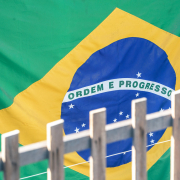The weather thus far this growing season in Brazil has been very good for soybeans and also for soybean rust development. Embrapa reported that there have been 55 confirmed cases of soybean rust in commercial soybeans fields in Brazil with 29 reported in Parana, 11 in Rio Grande do Sul, 6 in Santa Catarina, 5 in Sao Paulo, 3 in Minas Gerais, and 1 in Mato Grosso do Sul. Last year at this time, there had been 8 confirmed cases. The worst growing season was 2015/16 when there had been 92 cases by this date and the best growing season was 2007/08 when no rust had been reported by this date.
The number of confirmed cases this week represents the second most rust cases for this date since Embrapa started keeping track 13 years ago. In some states, the first case of soybean rust in commercial soybean fields was confirmed a month earlier than last year.
The state of Parana usually registers the most confirmed cases of soybean rust in Brazil probably because of two reasons. The first reason is due to the proliferation of volunteer soybeans between growing seasons. These volunteer soybeans can act as host plants for the disease keeping the spores viable from one growing season to the next.
The other reason is probably Parana’s close proximity to Paraguay, which is just across the Parana River from western Parana. The country of Paraguay does not have a soybean-free period during which no live soybean plants are permitted. Paraguay also allows farmers to plant two crops of soybeans during the same growing seasons, which is not permitted in Brazil. Having a second crop of soybeans prolongs the period of time during which the disease is active. This in turn, allows viable spores to be present at the start of the next growing season. Soybean rust spores are very light and can easily be blown into Brazil from fields in Paraguay.
The second most cases of soybean rust thus far is in the state of Rio Grande do Sul. Heavy rains in the state during October delayed the soybean planting and caused some of the soybeans to be replanted. As a result, the soybean crop is now developing later than normal, which could make it more susceptible to soybean rust.
Brazilian scientists are advising farmers to be very alert to the early signs of soybean rust in their fields and to be prepared to apply fungicides immediately after the disease is detected. They also advise farmers to rotate their fungicides and to be sure to use fungicides with the highest level of control.
Source: Agropages


